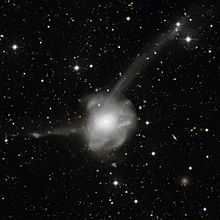NGC 7252
| NGC 7252 | |
|---|---|
|
A Hubble Space Telescope (HST) image of NGC 7252's core. | |
| Observation data (J2000 epoch) | |
| Constellation | Aquarius |
| Right ascension | 22h 20m 44.8s[1] |
| Declination | −24° 40′ 42″[1] |
| Redshift | 4792 ± 1 km/s[1] |
| Distance | 220 million light years |
| Type | (R)SA(r)0[1] |
| Apparent dimensions (V) | 1′.9 × 1′.6[1] |
| Apparent magnitude (V) | 12.7[1] |
| Other designations | |
| PGC 68612,[1] Arp 226,[1] Atoms for Peace Galaxy[1] | |
NGC 7252 is a peculiar galaxy resulting from an interaction between two galaxies that started a billion years ago. It is located 220 million light years away in the constellation Aquarius. It is also called Atoms for Peace galaxy, a nickname which comes from its loop-like structure, made of stars, that resembles a diagram of an electron orbiting an atomic nucleus.
General
NGC 7252 is located in the southern part of Aquarius. With an apparent magnitude of 12.7, it is bright enough to be seen by amateur astronomers as a faint small fuzzy blob. Large loops of gas and stars around it makes the galaxy quite peculiar. Thus, it is also Arp 226 (the 226th entry in Arp’s list of peculiar galaxies).
Naming
In December 1953, U.S. President Dwight D. Eisenhower gave the "Atoms for Peace" speech. The speech was concerned about promoting nuclear power for peaceful purposes. Significant to the scientific community, the name of the speech was given to this peculiar galaxy. The two galaxies merging also resembles nuclear fusion and the galaxies giant loops resemble a diagram of electrons orbiting the nucleus of an atom.
Interest
The galaxy is a result of a collision of two galaxies. This collision is an opportunity for astronomers to study such mergers and to predict the future of our Milky Way after its expected collision with the Andromeda galaxy.
X-ray emissions
X-ray emissions were observed in NGC 7252. This suggests the existence of nuclear activity or an intermediate-mass black hole in the galaxy.
Structure

The central region of the galaxy is home to hundreds of massive, ultra-luminous clusters of young stars that appear as bluish knots of light. These young clusters were created on the suspected galaxy merger, that pushed gases into these regions and caused a burst of star formation.
The most conspicuous of them is one known as W3, that has a mass of around 8*107 solar masses. This object, also the most luminous super star cluster known to date, has properties more similar to an ultra-compact dwarf galaxy and differs only of those galaxies because of its age (300-500 million years).[2]
A pinwheel-shaped disk, that is rotating in a direction opposite to that of the galaxy, is found deep inside Atoms for Peace that resembles a face-on spiral galaxy, yet it is only 10,000 light years across. It is believed that this pinwheel-shaped structure is a remnant of a collision between two galaxies. Within a few billion years, NGC 7252 will look like an elliptical galaxy with a small inner disk due to the exhaustion of the gases in the galaxy.
See also
NGC 7727, a similar galaxy in Aquarius too.
External links
- ESA homepage for the Hubble Space telescope Pictures and information on NGC 7252
- Atoms for Peace galaxy at ESO
- Article about Atoms for Peace galaxy
References
- ↑ 1.0 1.1 1.2 1.3 1.4 1.5 1.6 1.7 1.8 "NASA/IPAC Extragalactic Database". Results for NGC 7252. Retrieved 2007-05-03.
- ↑ Fellhauer, M.; Kroupa, P. (May 2005). "A possible formation scenario for the ultramassive cluster W3 in NGC 7252". Monthly Notices of the Royal Astronomical Society 359 (1): 223–227. Bibcode:2005MNRAS.359..223F. doi:10.1111/j.1365-2966.2005.08891.x.
